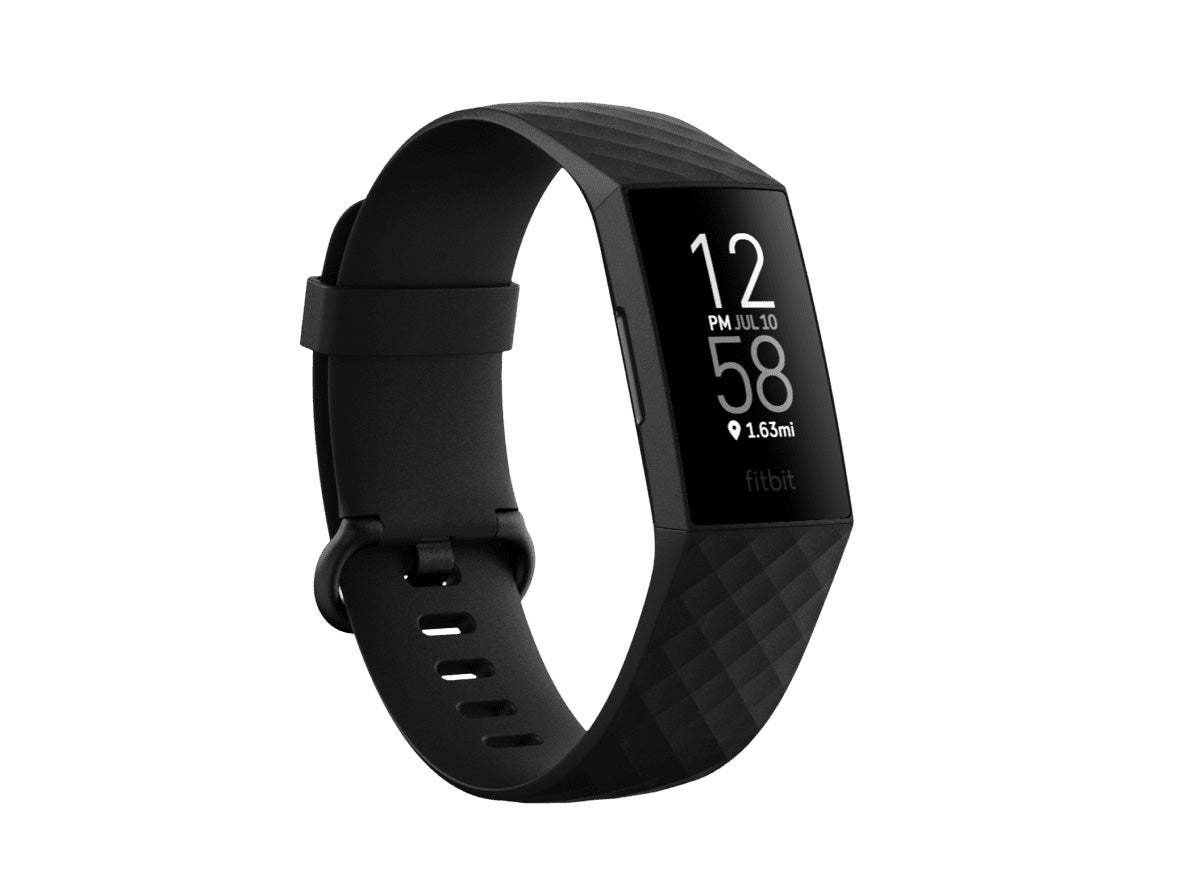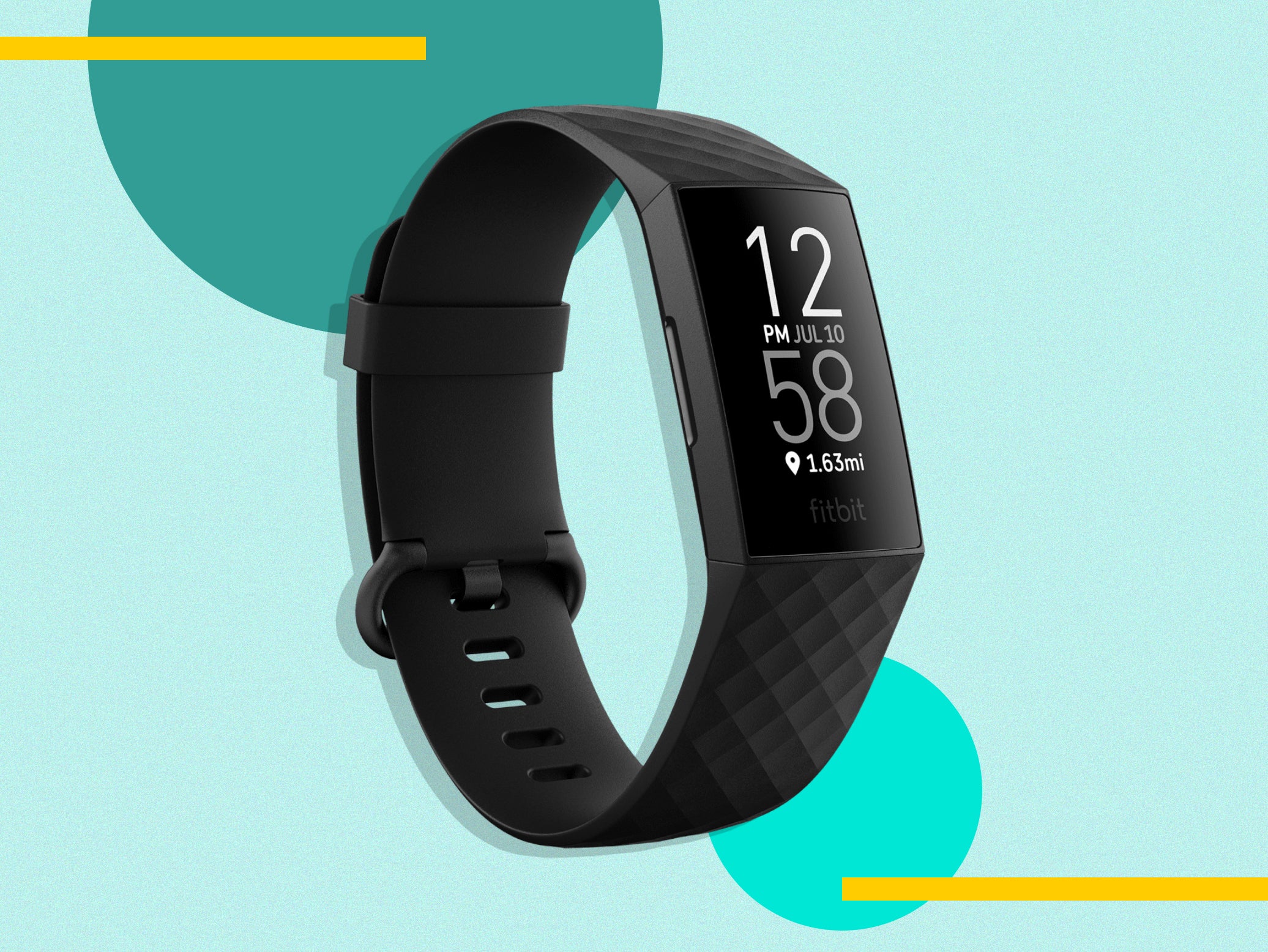Fitbit charge 4

- Dimensions: 35.8 x 22.7 x 12.5mm
- Display: Greyscale, touch sensitive
- Sensors: Heart rate, movement, sleep, skin temperature, GPS, NFC
- Features: Sleep score, stress management, menstrual health tracking, GPS, contactless payments
- Water resistance: 50 metres
- Rating: 4/5
Design and set-up
To our eyes, the Fitbit charge 4 is the archetypal fitness tracker. It is more compact than a smartwatch or dedicated running watch, but crams into its slim case enough features to fulfil the main duties of both of these devices. The charge 4 is light and discreet, slipping beneath a shift cuff or jumper sleeve without drawing attention to itself.
The strap does not attach using the industry-standard lug bars of a wristwatch, but it can be quickly removed and replaced if you want to give your Fitbit a different look. The all-black case won’t win any awards for its beauty, but it is functional and does the job without taking up much space on the wrist. You’ll quickly forget you are wearing it, and we even found the charge 4 comfy enough to wear at night without being annoying.
Much of the slightly curved glass front is taken up by the display. Greyscale instead of colour, this is a simple screen designed to deliver useful information instead of wowing you with HD graphics. Smartwatch users might be disappointed by the simplicity of the screen, but the greyscale technology helps the Fitbit last up to seven days on one charge. Also contributing here is how the display remains off until tapped, or until you raise your wrist, which causes it to light up and show the time.
At least that’s the intention here. We found the display’s waking up was a little hit-and-miss, with a more pronounced raising of the arm needed to wake it up. If you own a smartwatch without an always-on display then you’ll be familiar with this minor frustration. We also wish the display would stay on for slightly longer, as it dims and then goes off fairly quickly each time it is activated. However, we appreciate this is further contributing to the great battery life.
Read more: Fossil gen 6 smartwatch review 2021
The rear of the charge 4 houses a connection for the clip-on charging dock, and an optical heart rate sensor that takes a measurement every five seconds throughout the day, and every second while exercising.
Setting up the charge 4 is easy. Simply download the free Fitbit app (available for iOS and Android) and follow the instructions to create an account and connect the fitness tracker to your smartphone via Bluetooth.
The user interface is navigated by swiping at the display. This scrolls through screens of information for steps, activity, heart rate and sleep for the day. You can also see your weight and how much water you have drunk that day, but this data needs to be added to the app manually. Swiping to the sides shows other functions, such as a simple weather forecast app (which pulls data from your phone’s internet connection), Spotify control, timers, and a timed relaxation app. Pushing the single button on the left side of the charge 4 always takes you back to the previous menu.
Activity tracking
Once set up, the app works like most other fitness trackers. It counts your steps, floors climbed, distance walked and calories burnt each day, plus exercise sessions. For these, the app shows the duration of the exercise, your average heart rate and calories burnt. These are plotted on line graphs for closer analysis.
Sleep is automatically recorded each night, with data showing time spent in light, deep and REM sleep, plus time spent awake. Again, this is all plotted on line graphs for analysis, and the Fitbit app shows your sleep data over a 30-day average for a better look at long-term trends. As well as showing your own sleep data, the app shows what is typical for your age and gender.
Read more: Apple watch series 7 review 2021
To accurately track exercise, there are several presets to pick from on the Fitbit’s own interface. For example, you can pick swimming, then set the length of the pool for more accurate data collection, or specifically tell the charge 4 you are running on a treadmill instead of outside.
If you do choose to run outside, then the charge 4 has integrated GPS (unlike the charge 3). This means it can accurately log the route, speed and distance of your outdoor runs by itself – no need to have your smartphone with you. This is great for those who want to run without a phone, and brings the charge 4 closer to a dedicated running watch, but without the extra data – like cadence and splits – that casual runners can manage without. As with all fitness trackers, battery life takes a hit with prolonged use of GPS, so users who run outdoors regularly will find they need to top up the battery more often.
NFC tech onboard means it can make contactless payments through the Fitbit Pay system – perfect for making purchases while your phone is at home.
We think the Fitbit app offers a good amount of health and fitness tracking for most users. But if you’re left wanting more, there’s always Fitbit Premium. This subscription service is free for your first 90 days then costs £7.99 a month. It brings more content to the Fitbit app, including guided programmes to help you stick with the habits of a healthy lifestyle, workout routines, fitness challenges and mindfulness exercises. The service takes data collected by your Fitbit charge 4, then uses these statistics to help nudge you towards a healthier and more active lifestyle.

